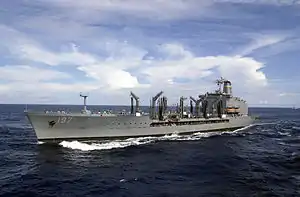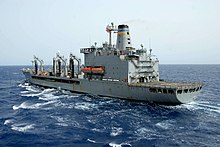USNS Pecos (T-AO-197)
USNS Pecos (T-AO-197) is a Henry J. Kaiser-class underway replenishment oiler operated by the Military Sealift Command to support ships of the United States Navy, and the third such ship to be named after the Pecos River.
 USNS Pecos (T-AO-197) | |
| History | |
|---|---|
| Name: | USNS Pecos |
| Namesake: | The Pecos River in New Mexico and Texas |
| Ordered: | 12 February 1987 |
| Builder: | Avondale Shipyard, Inc., New Orleans, Louisiana |
| Laid down: | 17 February 1988 |
| Launched: | 23 September 1989 |
| In service: | 6 July 1990-present |
| Identification: |
|
| Honors and awards: |
|
| Status: | In active Military Sealift Command service |
| General characteristics | |
| Class and type: | Henry J. Kaiser-class fleet replenishment oiler |
| Type: | Fleet replenishment oiler |
| Tonnage: | 31,200 deadweight tons |
| Displacement: |
|
| Length: | 677 ft (206 m) |
| Beam: | 97 ft 5 in (29.69 m) |
| Draft: | 35 ft (11 m) maximum |
| Installed power: |
|
| Propulsion: | Two medium-speed Colt-Pielstick PC4-2/2 10V-570 diesel engines, two shafts, controllable-pitch propellers |
| Speed: | 20 knots (37 km/h; 23 mph) |
| Capacity: |
|
| Complement: | approx. 88 (18 civilian officers, 1 U.S. Navy Chief Petty Officer, 64 merchant mariners, ~5 U.S. Navy enlisted personnel) |
| Armament: |
|
| Aircraft carried: | None |
| Aviation facilities: | Helicopter landing platform |
| Notes: |
|
Pecos, the eleventh Henry J. Kaiser-class ship, was laid down on 17 February 1988 at Avondale Shipyards in New Orleans, Louisiana, and launched on 23 September 1989. She was delivered to the Navy and placed in non-commissioned service with a primarily civilian crew under the control of the Military Sealift Command on 6 July 1990. The ship is equipped with a helicopter platform to allow for at-sea transfer of personnel and supplies.
Pecos is part of the MSC Naval Auxiliary Force, MSC Pacific, in the United States Pacific Fleet, and has received the National Defense Service Medal, the Armed Forces Expeditionary Medal twice, and the Southwest Asia Service Medal.
On 9 December 1999 a United States Marine Corps CH-46 helicopter crashed into Pecos and sank while participating in a training mission. Seven of the 18 personnel on board the helicopter were killed in the accident. As routine procedure following an accident, members of the crew were subjected to drug testing. Captain Mark LaRochelle, the ship's Master, failed the initial and secondary drug tests and was subsequently relieved of command and fired from the Military Sealift Command. Following his dismissal from MSC, his US Coast Guard license was revoked.
During Operation Tomodachi, Pecos rendezvoused with United States Seventh Fleet flagship USS Blue Ridge near Kyushu, Japan. Blue Ridge transferred 96 pallets of humanitarian assistance and disaster relief material to Pecos for delivery to the Essex Amphibious Group and Carrier Strike Group 5. Weighing as much as 1,000 pounds (450 kg) each, the pallets contained water containers and water purification tablets, first-aid products, tarpaulins, blankets, and other supplies. The ship arrived off Sendai on 25 March for more underway replenishment operations. During her support effort to Operation Tomodachi, Pecos completed nine underway replenishments and delivered more than 2.3 million U.S. gallons (8.7 million liters) of fuel to other supporting ships.[2] Pecos helped refuel USS Harry S. Truman and HMS Defender in 2016.[3]

On 28 November 2018, the United States Navy sent Pecos and USS Stockdale through the Taiwan Strait as a demonstration of the "U.S. commitment to a free and open Indo-Pacific," according to a U.S. Pacific Fleet spokesman. The transit took place only a few days before a planned meeting between U.S. President Donald Trump and Chinese President Xi Jinping at the G20 summit in Buenos Aires, Argentina.[4][5]
References
- http://www.msc.navy.mil/sealift/2011/May/japan.htm
- https://navynews.co.uk/archive/news/item/14125
- Pickrell, Ryan (28 November 2018). "US Navy warships just rocked the Taiwan Strait in a power play ahead of Trump's meeting with the Chinese president". businessinsider.com. Business Insider. Retrieved 29 November 2018.
- Sabga, Patricia (29 November 2018). "Breakthrough, escalation or pause? Trump, Xi set to meet at G20". aljazeera.com. Al Jazeera. Retrieved 29 November 2018.
- This article incorporates text from the public domain Dictionary of American Naval Fighting Ships.
- This article includes information collected from the Naval Vessel Register, which, as a U.S. government publication, is in the public domain. The entry can be found here.
- "T-AO-197 Pecos". Fleet Oiler (AO) Photo Index. Archived from the original on March 8, 2005. Retrieved April 4, 2006.
- "Search intensifies for 7 Marines after helicopter crash". CNN. Retrieved February 27, 2007.
External links
| Wikimedia Commons has media related to IMO 8706686. |
- NavSource Online: Service Ship Photo Archive USNS Pecos (T-AO-197)
- USNS Pecos (T-AO-197)
- Footage from YouTube of the CH-46 accident on 9 DEC 1999.
- CNN.com article regarding the CH-46 accident on 9 DEC 1999.
- Wildenberg, Thomas (1996). Gray Steel and Black Oil: Fast Tankers and Replenishment at Sea in the U.S. Navy, 1912-1995. Annapolis, Maryland: Naval Institute Press. Retrieved 2009-04-28.
